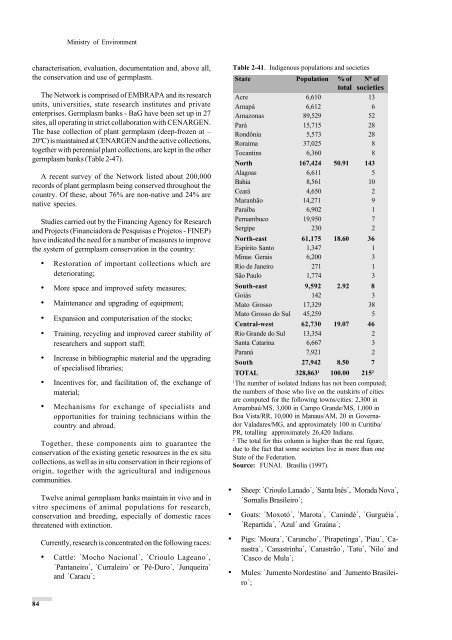Brazil (Part VIII, English version) - Convention on Biological Diversity
Brazil (Part VIII, English version) - Convention on Biological Diversity
Brazil (Part VIII, English version) - Convention on Biological Diversity
- No tags were found...
Create successful ePaper yourself
Turn your PDF publications into a flip-book with our unique Google optimized e-Paper software.
Ministry of Envir<strong>on</strong>mentcharacterisati<strong>on</strong>, evaluati<strong>on</strong>, documentati<strong>on</strong> and, above all,the c<strong>on</strong>servati<strong>on</strong> and use of germplasm.The Network is comprised of EMBRAPA and its researchunits, universities, state research institutes and privateenterprises. Germplasm banks - BaG have been set up in 27sites, all operating in strict collaborati<strong>on</strong> with CENARGEN.The base collecti<strong>on</strong> of plant germplasm (deep-frozen at –20ºC) is maintained at CENARGEN and the active collecti<strong>on</strong>s,together with perennial plant collecti<strong>on</strong>s, are kept in the othergermplasm banks (Table 2-47).A recent survey of the Network listed about 200,000records of plant germplasm being c<strong>on</strong>served throughout thecountry. Of these, about 76% are n<strong>on</strong>-native and 24% arenative species.Studies carried out by the Financing Agency for Researchand Projects (Financiadora de Pesquisas e Projetos - FINEP)have indicated the need for a number of measures to improvethe system of germplasm c<strong>on</strong>servati<strong>on</strong> in the country:• Restorati<strong>on</strong> of important collecti<strong>on</strong>s which aredeteriorating;• More space and improved safety measures;• Maintenance and upgrading of equipment;• Expansi<strong>on</strong> and computerisati<strong>on</strong> of the stocks;• Training, recycling and improved career stability ofresearchers and support staff;• Increase in bibliographic material and the upgradingof specialised libraries;• Incentives for, and facilitati<strong>on</strong> of, the exchange ofmaterial;• Mechanisms for exchange of specialists andopportunities for training technicians within thecountry and abroad.Together, these comp<strong>on</strong>ents aim to guarantee thec<strong>on</strong>servati<strong>on</strong> of the existing genetic resources in the ex situcollecti<strong>on</strong>s, as well as in situ c<strong>on</strong>servati<strong>on</strong> in their regi<strong>on</strong>s oforigin, together with the agricultural and indigenouscommunities.Twelve animal germplasm banks maintain in vivo and invitro specimens of animal populati<strong>on</strong>s for research,c<strong>on</strong>servati<strong>on</strong> and breeding, especially of domestic racesthreatened with extincti<strong>on</strong>.Currently, research is c<strong>on</strong>centrated <strong>on</strong> the following races:• Cattle: ´Mocho Naci<strong>on</strong>al´, ´Crioulo Lageano´,´Pantaneiro´, ´Curraleiro´ or ´Pé-Duro´, ´Junqueira´and ´Caracu´;Table 2-41. Indigenous populati<strong>on</strong>s and societiesState Populati<strong>on</strong> % of Nº oftotal societiesAcre 6,610 13Amapá 6,612 6Amaz<strong>on</strong>as 89,529 52Pará 15,715 28R<strong>on</strong>dônia 5,573 28Roraima 37,025 8Tocantins 6,360 8North 167,424 50.91 143Alagoas 6,611 5Bahia 8,561 10Ceará 4,650 2Maranhão 14,271 9Paraíba 6,902 1Pernambuco 19,950 7Sergipe 230 2North-east 61,175 18.60 36Espírito Santo 1,347 1Minas Gerais 6,200 3Rio de Janeiro 271 1São Paulo 1,774 3South-east 9,592 2.92 8Goiás 142 3Mato Grosso 17,329 38Mato Grosso do Sul 45,259 5Central-west 62,730 19.07 46Rio Grande do Sul 13,354 2Santa Catarina 6,667 3Paraná 7,921 2South 27,942 8.50 7TOTAL 328,863 1 100.00 215 21The number of isolated Indians has not been computed;the numbers of those who live <strong>on</strong> the outskirts of citiesare computed for the following towns/cities: 2,300 inAmambaú/MS, 3,000 in Campo Grande/MS, 1,000 inBoa Vista/RR, 10,000 in Manaus/AM, 20 in GovernadorValadares/MG, and approximately 100 in Curitiba/PR, totalling approximately 26,420 Indians.2The total for this column is higher than the real figure,due to the fact that some societies live in more than <strong>on</strong>eState of the Federati<strong>on</strong>.Source: FUNAI. Brasília (1997).• Sheep: ´Crioulo Lanado´, ´Santa Inês´, ´Morada Nova´,´Sornalis Brasileiro´;• Goats: ´Moxotó´, ´Marota´, ´Canindé´, ´Gurguéia´,´Repartida´, ´Azul´ and ´Graúna´;• Pigs: ´Moura´, ´Caruncho´, ´Pirapetinga´, ´Piau´, ´Canastra´,´Canastrinha´, ´Canastrão´, ´Tatu´, ´Nilo´ and´Casco de Mula´;• Mules: ´Jumento Nordestino´ and ´Jumento Brasileiro´;84
















